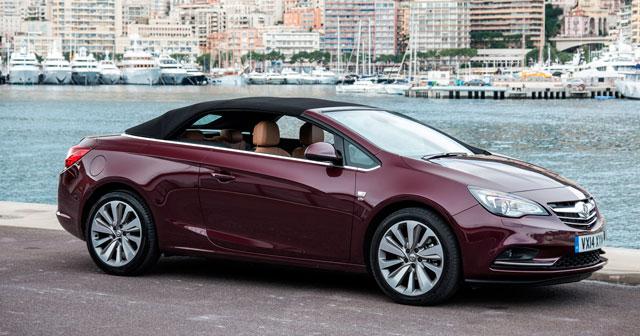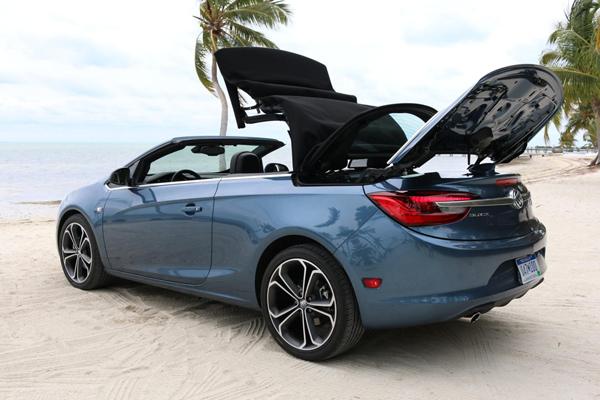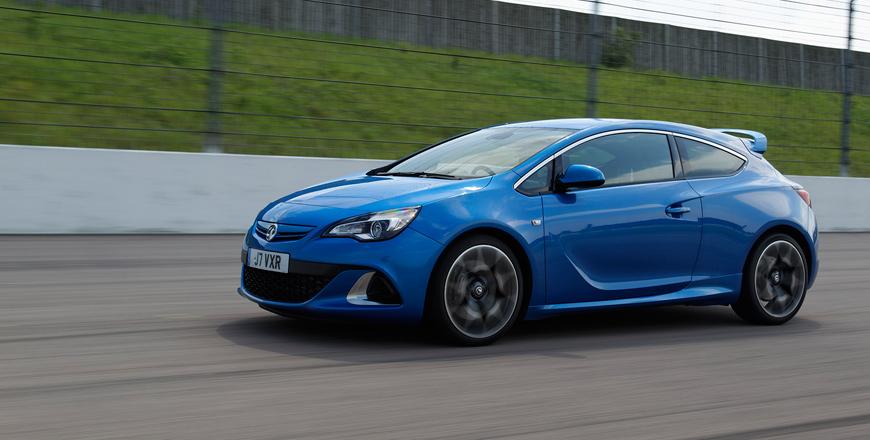You are here
The everyday all-weather drop-top
By Ghaith Madadha - Apr 06,2015 - Last updated at Apr 06,2015

Launched in 2013 as a practical mid-size four-seat convertible with premium car features, feel and qualities yet with attainable price points, the Vauxhall Cascada is essentially based on a lengthened version of the Vauxhall Astra family hatchback and coupe platform.
Practical and spacious, the Cascada was designed to be a viable only car for a household, and for year-round drop-top motoring.
Offered with a range of powerful, gutsy and economical turbocharged petrol and diesel engines, the Cascada drives with a reassuringly planted “big car” confidence that Vauxhall does so well, and features an extensive list of premium convenience and safety equipment.
Sold as a Vauxhall in the UK where it was driven, the Cascada is identically available in most markets under parent company General Motors’ German Opel badge, and was introduced to North America under the Buick badge as of 2015.
Founded in 1857, Vauxhall became a carmaker by 1903 and General Motors subsidiary by 1925. An indigenous British brand, Vauxhall began merging with Opel by the mid-1970s, and now fields a near identical model line-up.
Resiliently popular, Vauxhall maintained its’ long-held position as Britain’s second best-selling car through the global financial crisis, and holds a comparatively stronger position in the UK than Opel does in its combined global market.
Upmarket aesthetic
With only right-hand-drive configuration and Griffen badge differentiating from its Opel sister, even the now circular Vauxhall badge fits the same recess as the German brand. As a model, the Cascada’s details may differ slightly for a slightly more upmarket position, but to the trained eye it is almost immediately identifiable as an un-official or quasi Astra convertible.
With more elegant and relaxed front design, the Cascada’s horizontally uninterrupted bumper and less aggressive lower intakes emphasise width. The Cascada’s grille features a prominent chrome horizontal centre slat, which is reflected with a similar chrome strip running through and connecting the high set rear lights.
An elegant and swept-back design with a lower roofline and clean uninterruptedly rising waistline — flush with roof down — the Cascada features subtly muscular surfacing including an L-shaped lower flank crease, while the driven car’s large optional 19-inch alloys complemented its high rear deck.
Built on the same 10mm longer Astra GTC coupe wheelbase for added stability, the longer Cascada is just 2mm shorter than the Astra Sports Tourer estate version. The longer body both provides a more elegantly upmarket aesthetic and the necessary space to accommodate the flush folding fabric roof behind the rear seats while allowing for a sufficiently practical and spacious luggage compartment.
Indefatigable diesel
Offered with a choice of efficient and versatile turbocharged engines the Cascada can be had with 138BHP 1.4-litre and 168BHP and 197BHP 1.6-litre direct injection petrol engines. And it is testament to how clean and smooth European diesel engines and fuel have become that convertibles are offered as oil burners, with the Cascada featuring two powerful 2-litre turbodiesel engines of 163BHP and 192BHP.
Driven with the range-topping 2.0 CDTI BiTurbo engine introduced last year, the Cascada develops 192BHP at 4,000rpm and gut-wrenching 295lb/ft peak torque throughout 1,750-2,500rpm. Only available with a six-speed manual gearbox in CDTI BiTurbo guise, other engine options can be specified with automatic transmission.
With little low-end lag typical of turbodiesel engines, the Cascada’s twin-turbochargers spools up quickly to deliver effortlessly flexaible mid-range sledgehammer torque, which soon gives way to peak power.
Charging through 0-100km/h in 8.9 seconds, the Cascada feels yet quicker in daily driving, where mid-range overtaking manoeuvres are completed with utterly muscular assurance, whether in town or at speed in top gear.
Smooth and refined, the Cascada’s engine is well-insulated from diesel-clatter, and with stop/start function, fuel consumption is frugal at 5.2 litres/100km, combined. Working through ratios to keep the Cascada’s mid-range engine sweet spot, shifts are satisfyingly precise and notchy, while clutch pedal travel is light and biting point intuitive.
‘Big car’ feel
Channelling its’ vast torque through the driven front wheels, the Cascada can easily unstuck otherwise grippy tyres, sending them scrambling for traction when launched aggressively with electronic stability and traction controls switched off. To mitigate torque steer when launching or coming back on power out of corners, the Cascada uses HiPerStrut front suspension, which is a modified MacPherson-type suspension with a separate steering axis knuckle.
Weighing a hefty 1,816kg owing to high equipment levels and structural reinforcements compensating for rigidity lost by chopping off the roof, the Cascada well controls weight transfer and body through corners, while rebound control is buttoned down and settled. Adaptive dampers can be optionally specified.
Sophisticated, smooth and firmly comfortable on road, only the most jagged potholes disturb the Cascada’s refined ride. Big sticky 235/45R19 tyres provide excellent grip, but standard 235/50R18 tyres would expectedly be more supple.
Indefatigably effortless and confidently composed on highways, the Cascada has a ‘big car’ feel to it, with superbly pinned down stability and smoothness for relaxed long distance touring capability. A refined and well built car, the Cascada feels almost as rigid as a fixed head Astra, while wind noise is seldom noticed for a fabric roof convertible. Electric-assisted steering is light and well-damped from vibrations, while brakes are reassuringly effective, with ABS and electronic brakeforce distribution.
Comfort and equipment
Comfortable, well spaced and extensively-equipped, the Cascada is a practical everyday all-weather convertible. With quick-acting heating, heated seats and steering, side window defroster, dual-zone climate control and wind deflector for two- or four-seat use, top-down driving was possible in freezing UK January weather.
Practically, the quick electric folding roof stows behind the rear seats at up to 50km/h, while generous 380-litre boot space expands to 750 litre with the rear seats folded. With roof down, luggage space contracts to 280 and 650 litres, but configuration becomes narrow under the stowed roof. Front cabin space is generous and rear seat access and space is adequate for regular adult use.
With big comfortable and supportive seats with four-way adjustable lumbar support, thick flat-bottom adjustable steering, refined soft texture surfaces and quality leather upholstery, the Cascada has a premium car feel and generous equipment levels in top-of-the-range Elite spec, as driven.
Too long to list in full, Elite spec features include rain-sensitive windscreen wipers, anti-dazzle rear mirror, electric seatbelt presenters, ambient interior lighting, remote roof operation and automatic lighting control with high beam assist.
Elegant and business-like with chrome accents, the Cascada’s centre console is busy but user-friendly. Infotainment systems include Bluetooth and satnav. Safety equipment includes active head restraints and rollover protection, multiple airbags, Isofix child seat latches and reversing camera among other features.
TECHNICAL SPECIFICATIONS
Engine: 2-litre, transverse in-line twin-turbo diesel 4 cylinders
Bore x stroke: 83 x 90.4mm
Compression ratio: 16.5:1
Valve-train: 16-valve, DOHC, common-rail direct injection
Gearbox: 6-speed manual, front-wheel drive
Final drive ratio: 3.9:1
Power, BHP (PS) [kW]: 192 (195) [143] @4,000rpm
Specific power: 92.8BHP/litre
Power-to-weight: 105.7BHP/tonne
Torque, lb/ft (Nm): 295 (400) @1,750-2,500rpm
Specific torque: 204.5Nm/litre
Torque-to-weight: 220.2Nm/ton
0-100 km/h: 8.9 seconds
Top speed: 230km/h
Fuel capacity: 56 litres
Fuel economy, urban/extra-urban/combined: 6.3-/4.6-/5.2-litres/100km
Carbon dioxide emissions, combined: 138g/km
Length: 4,696mm
Width: 1,839mm
Height: 1,443mm
Wheelbase: 2,695mm
Track, F&R: 1,587mm
Overhang, F/R: 975/1,026mm
Luggage volume, min-max, roof up/down: 380-750-/280-650 litres
Kerb weight: 1,816kg
Steering: Electric-assisted speed sensitive rack & pinion
Turning radius: 12.2 metres
Suspension, F: HiPerStrut (MacPherson struts with independent steering axis pivot)
Suspension, R: Watt’s link semi-independent
Brakes, F/R: Ventilated discs/discs
Tyres: 235/45R19 (optional)
Related Articles
MALIBU, California — These are tough times for convertibles.Except for a handful of performance, luxury cars or subcompacts, most of t
First introduced in 2009 and face-lifted in 2012, the Opel Astra “J” series may have been replaced in European and other markets by a succes
A sleek, stylish and brutally quick compact three-door coupe that will go down in history as last great hurrah for Britain’s Vauxhall brand,



















